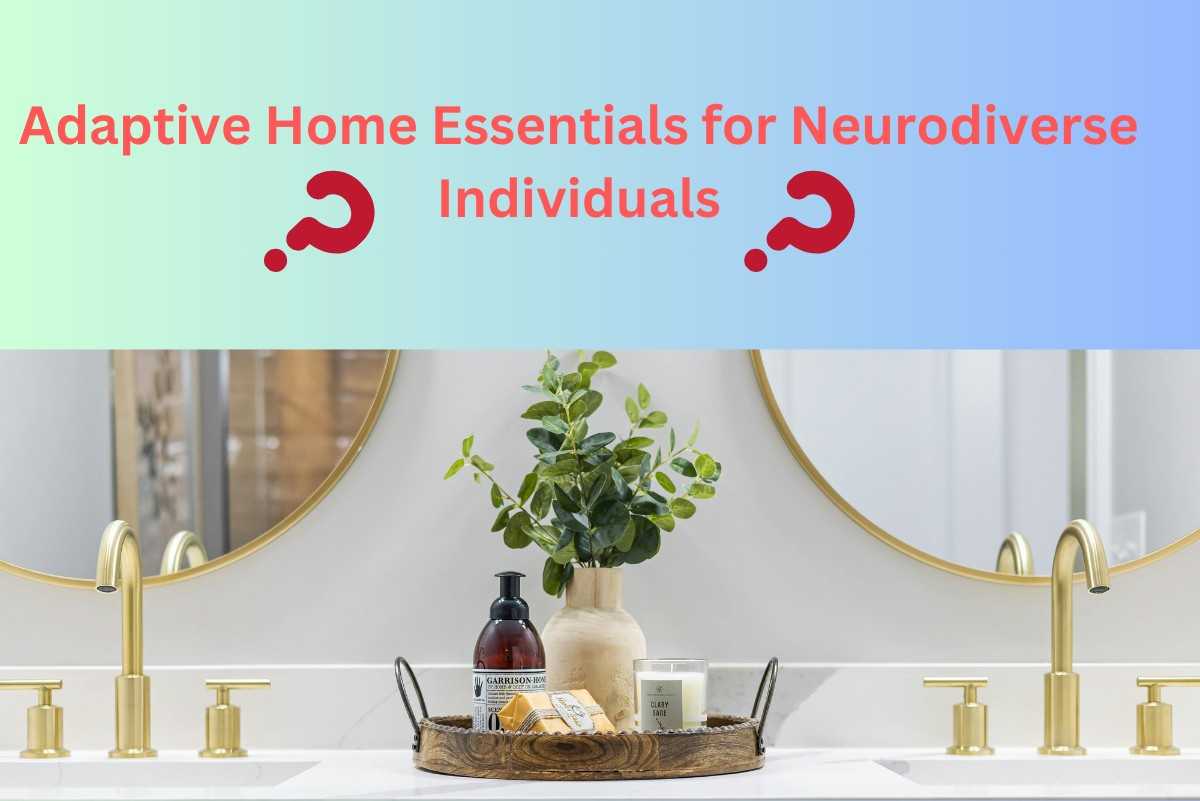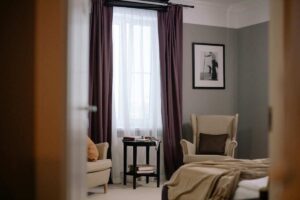The design of homes for neurodiverse individuals serves multiple purposes beyond efficiency because it builds nuanced environments enabling comfort and power alongside inclusivity. A selection of transformations in home interiors designed for neurodiverse residents allows living spaces to develop into environments that support both relaxation and work efficiency and individual self-expression. Each detail in an environment design serves to aid sensory and cognitive requirements of unique individuals so the environment supports them properly.
These strategies extend past aesthetic design since they involve the setup of soundproof areas and weighted blanket implementations as well as visual scheduling systems. Each adapted solution addresses the physical, emotional and sensory needs of the individual. This piece features crucial ideas along with inventive solutions that can transform your home into a space that honors neurodiverse differences.
The following guide shows how adapting home essentials for neurodiverse Individuals enhances daily life experience without compromising design aesthetics. Ready to redesign your space? After reviewing these points you will understand everything about this topic.
What to Know About Adaptive Home Essentials for Neurodiverse Individuals
Designing homes for neurodiverse individuals requires creating solutions that simultaneously improve comfort while also reducing sensory challenges while supporting independence. We present here useful design strategies to demonstrate how adaptive home essentials for neurodiverse individuals produce supportive residential environments.
Below Here are Great Solutions
Sensory-Friendly Lighting Solutions
Noise Reduction Strategies
Calming Color Schemes
Organizational Systems
Weighted Blankets and Lap Pads
Fidget Tools and Sensory Accessories
Textured Wall Panels and Fabrics
Flexible Furniture Arrangements
Visual Schedules and Timers
Scent-Free or Controlled Scent Environments
Ergonomic Seating Options
Safe Zones or Retreat Spaces
Adaptive Kitchen Tools
Non-Slip Flooring Materials
Smart Home Technology Integration
Personalized Artwork and Decor
Routine Maintenance of Sensory Tools
Community Resource Connection
Inclusive Family Involvement
Continuous Assessment and Adjustment
Understanding Sensory-Friendly Lighting
Lines of illumination exist to support those who react negatively to excessive light exposure or experience comfort needs for certain beam intensity. People who are neurodiverse along with those with autism and ADHD and sensory processing disorders commonly experience problems with traditional lighting which becomes overwhelming and disruptive. Sensory-friendly design choices allow you to build a more comfortable space that welcomes everyone.
Benefits of Sensory-Friendly Lighting
- Reduced Overstimulation
- Improved Emotional Regulation
- Enhanced Sleep Quality
- Increased Productivity
Sensory-Friendly Lighting for Different Rooms
- Living Areas: You should use adjustable lights from the ceiling combined with accent illumination because these offer useful height adjustment. Add dimmers for evening relaxation.
- Bedrooms: Regular background lighting should be chosen at low intensities that build a calm setting for better sleep.
- Workspaces: Well-directed task illumination should be deployed for productive work areas to prevent disruptive glare from occurring.
- Bathrooms: Placing gentle lighting fixtures around washroom mirrors will eliminate intense mirror reflections.
Noise Reduction Strategies
For individuals with neurodiversity who experience sensitivity to sounds noise functions as a substantial cause of mental distress. Home environments become both peaceful and focused through the deployment of noise reduction solutions.
Soundproofing Materials: Acoustic panels when used with soundproof curtains or rugs achieve effective noise reduction by absorbing ambient noise while decreasing echo generation. The room-improving materials are practical to implement and provide efficient noise reduction for study spaces and bedrooms.
White Noise Machines: Calm sound-emitting devices producing waves of wave sounds or rain sounds function to silence intrusive disturbances therefore enhancing concentration and helping users sleep better.
Noise-Canceling Headphones: Most neurodiverse folks with concentration needs find noise-canceling headphones essential to create quiet isolation in communal homes.
Calming Color Schemes
Sensory-friendly domestic environments depend heavily on color psychology for their implementation. The strong color sensitivity of neurodiverse people allows well-selected color schemes to promote relaxation while minimizing sensory tension.
Neutral Tones: People who want to relax will find comfort in using walls painted with beige alongside mild blues and pleasant green tones.
Avoid High Contrast: Daemon patterns along with extreme color variations produce visual discomfort to cognitive abilities. Choose either monochromatic schemes or subtle gradients for your design.
Customizable Spaces: People can customize their environment through removable wallpaper patches and paint elements that aid personal self-expression.
Organizational Systems
People who need routine find that an organized living environment provides both control and predictability.
- Labeled Storage: Visibility through transparent storage pieces along with printed text and icon labels enables swift item discovery thus minimizing frustration.
- Color-Coded Systems: Multipurpose identification works best when you introduce color coding within your system by using green for office items and red for kitchen supplies.
- Visual Schedules: Electronic scheduling tools together with wall-mounted planner systems track daily activities while creating clear expectations.
Weighted Blankets and Lap Pads
Deep pressure stimulation (DPS) provides two beneficial effects for people with autism by lowering their anxiety and enhancing their attention span. When used these items create the same comfort level as a supportive embrace just like a hug.
- Weighted Blankets: The diverse range of weighted blanket weights suits everyone and provides outstanding sleep quality benefits.
- Lap Pads: These portable products insert deep pressure stimulation into daily life while people read books study material or sit for television time.
- DIY Options: Households can make affordable weighted products from rice-filled pouches to meet individual usage needs.
Fidget Tools and Sensory Accessories
Neurodiverse people rely on fidgeting behavior to control their nervous system and maintain their attention. Tools exist that meet sensory requirements across diverse needs.
- Popular Fidget Tools: Items like stress balls, spinners, and putty offer tactile engagement.
- Custom Kits: Devices differ based on individual preferences so use kit assembly options to select preferred textures along with activities and shapes for tailored benevolent assistance.
- Integration in Decor: Build sensory comfort into home decorations through daily furnishings that include touch-sensitive materials such as soft textured rugs and cushions.
Textured Wall Panels and Fabrics
The need for bodily touch stimulates many people with neurodevelopmental variations. Spaces with multiple textured surfaces offer enhanced sensory explorations to users.
- Textured Panels: A sensory experience can be generated by installing wall surfaces with decorative textures and patterns and embossed artwork.
- Soft Furnishings: Throw pillows along with blankets of different material textures and_layouts from velvet,_IAenile and faux fur can add appeal to your interior spaces.
- DIY Textures: Use regular home materials like sandpaper and felt and cork to build tactile sensory walls and texture panels.
Flexible Furniture Arrangements
Flexibility in furniture arrangements enables users to create personal space designs which match their comfort requirements and sensorial needs.
- Modular Furniture: Different room needs benefit from furniture items that transform between sectional sofas and extendable tables.
- Moveable Dividers: Add portable partitions to create quiet zones or shut down areas which cause unnecessary sensory stimulation.
- Open Spaces: The arrangement should be uncluttered to create room which encourages both movement and play.
Visual Schedules and Timers
Organizational routines together with proper structure prove critical for people whose minds operate uniquely. Clear consistent signals emerge through visual tools alongside timing mechanisms.
- Daily Planners: Daily schedules using physical and digital platforms through images or icons function to display tasks alongside activities.
- Countdown Timers: Visual timers through hourglasses or digital timer applications assist users in transitioning through their work schedule.
- Routine Boards: Users can design flexible daily routines using Velcro charts and magnetic boards.
Scent-Free or Controlled Scent Environments
Neurodiverse individuals encounter disturbances because of sensitive reactions to smells. Environmental odor management stands as an essential necessity for adaptation.
- Avoid Strong Scents: People should prefer minimally scented chemical-free cleaning supplies along with odorless personal hygiene and resale products.
- Controlled Aromatherapy: The calming effects of essential oil scents such as lavender and chamomile can be created with diffusers but users must choose agreeable and mild solutions.
- Air Purifiers: Residential air purifiers can treat environmental pollutants while eliminating noxious smells which keeps sensitive users free from allergens.
Ergonomic Seating Options
The right support from comfortable seating will protect your posture while minimizing physical issues that interrupt both focus and relaxation.
- Adjustable Chairs: Flexible seating must allow patients to modify both height settings along with backrest options.
- Specialized Cushions: Thankfully exist various options that enhance sitting comfort in long periods consisting of lumbar supports and seat pads and wedge cushions.
- Varied Seating Options: Provide different seating options including beanbags and rocking chairs which combined with kneeling stools serve users with varying needs.
Safe Zones or Retreat Spaces
Neurodiverse individuals benefit from escape pods in their environment to reduce stress and control their bodily responses.
- Quiet Corners: Emergency rooms should include soft instrumentation along with noise-cancelation equipment and dim lighting.
- Personalized Decor: Neurodiverse parents should add calming items which might include favorite books along with pictures and sensory toys.
- Privacy Enhancements: Make secluded areas with curtains and canopies together with room dividers.

Adaptive Kitchen Tools
For people with neurodiverse conditions the kitchen environment often proves difficult to handle. People using adaptive tools experience greater access together with higher independence.
- User-Friendly Utensils: Easy-grip knives together with spill-proof bowls enable people to do cooking tasks effortlessly.
- Color-Coded Tools: Brightly colored kitchen devices help users organize items better and use them more easily.
- Safety Features: Automated appliance shutdown systems should become standard equipment for homes to prevent various potential dangers.
Non-Slip Flooring Materials
A sensory-friendly home requires highest priority to safety considerations. Non-slip flooring both prevents risks and gives users secure footing.
- Textured Tiles: The application of anti-slip tile coatings must be done in kitchens and bathrooms which represent high-risk zones.
- Rubber Mats: Rubber-based mats should go in spaces that combine play activities with study responsibilities to improve floor stability.
- Low-Pile Carpets: Install floors that combine non-slippery carpet materials with safe rubber backing instead of slippery or loose surfaces.
Smart Home Technology Integration
Through smart technology individuals with neurodiversity gain simplified daily functions while receiving improved access to facilities.
- Voice-Activated Assistants: Home devices powered by Alexa and Google Assistant enable users to control lighting appliances and set reminders.
- Automated Systems: Automated systems enable users to specify timings for lights and heating systems and play music through programming to eliminate direct management requirements.
- Remote Monitoring: Through smart camera monitoring systems and safety alerts parents and caregivers can evaluate their children’s safety conditions from anywhere.
Personalized Artwork and Decor
Individualized home decoration creates a sanctuary which connects personal themes to comfort zones.
- Familiar Items: Meaningful memories displayed as photos or artwork combined with memorabilia help produce a soothing space.
- Interactive Decor: Safety environments can benefit from touch-interactive decorations along with mountable surfaces that encourage children to actively touch for stimulation.
- Neutral Themes: People should select soothing designs when remodeling spaces because excessive stimulation leads to poor results.
Routine Maintenance of Sensory Tools
Sensory equipment effectiveness stays high and security aspects stay optimal due to proper periodic maintenance.
- Cleaning Protocols: For sensory equipment like weighted blankets and fidget tools and sensory tools specific cleaning and maintenance schedules must be created.
- Replacement Plans: Regular inspection of wear-damage should be followed by timely item replacements.
- Storage Solutions: Putting sensory tools within easy reach will promote regular utilization of the tools.
Community Resource Connections
Communities that stay connected to local resources enable people to access evolving adaptive products including support systems.
- Workshops and Events: Organize your participation in community events which promote sensory-friendly adaptations.
- Support Groups: Platforms with discussion areas and groups near you offer members an opportunity to network and share sensory ideas and experiences.
- Product Demos: Community organizations together with retailers provide test opportunities for adaptive products.
Inclusive Family Involvement
When families create supportive environments their adoption of sensory-friendly adaptations becomes more effective.
- Collaborative Design: Involving all members of the family allows for accurate selection of adaptive tools together with innovative layouts.
- Shared Spaces: The space design must find equilibrium between allowing private requirements and purposes alongside shared utilities.
- Open Communication: You should have periodic discussions which identify successful practices and lead to necessary adjustments.
Continuous Assessment and Adjustment
Regular assessments help your home evolve since needs transform over time thus maintaining functionality alongside support services.
- Feedback Loops: Free all stakeholders to share personal feedback while giving recommendations to improve spaces.
- Professional Consultations: Sensory award-winning designers and occupational therapists collaborate to design sensory-friendly environments.
- Flexibility in Design: Your building strategy should include flexible options which can accommodate changes in requirements.
Wrap up with Adaptive Home Essentials for Neurodiverse Individuals
The foundation of comfort and productivity starts with achieving proper adaptive home essentials for Neurodiverse Individuals . All families that adopt these strategies will develop nurturing areas which create a smooth environment for each person. These modifications including noise reduction alongside adaptive tools with sensory-friendly lighting bring deep meaningful changes to daily routines.
Injecting humor into your adaptations for essential home functionality will enhance your neurodiverse development plans
A sensory-friendly neurodiverse household setup does not require hard scientific knowledge beyond smart lighting implementation. Thanks go out to Wi-Fi divinities if you attempt that installation. Your design of adaptable house essentials for neurodiverse people transforms into a supportive environment that goes beyond building just a house Celebrate more stable moods and greater composure while humor keeps each design decision brighter.
FAQs about adaptive home essentials for neurodiverse individuals
1. The essential adaptive home tools which accommodate neurodiverse individuals’ needs seek to deliver improved comfort and functionality?
Tools and designs made specifically for sensory and cognitive needs function to provide comfort alongside functional benefits.
2. Neurodiverse people experience better mental and physical well-being through sensory-friendly lighting systems.
A properly designed sensory lighting system helps protect against sensory overload while supporting concentration and relaxation and delivering restful sleep.
3. Signs for implementing effective Sensory Lighting Solutions include which methods deliver the most beneficial reductions?
Build sound-retaining panels and operate white noise machines together with noise-blocker headphones to make personal areas quieter.
4. Why are weighted blankets beneficial?
Through their application of deep pressure they both relieve anxiety and enhance sleep patterns.
5. What are flexible furniture arrangements?
Managers should design flexible settings through reconfigurable furniture systems which address personal choices and accommodate diverse needs.
6. Warmer homes – which smart technology benefits the neurodiverse population?
The technology performs automated functions while allowing voice-controlled modifications to simplify everyday tasks.


